Winter Semester 2021-22
03.11.2021: Dr. Diego F. Morales-Briones. Systematics, Biodiversity and Evolution of Plants, Ludwig-Maximilians University of Munich, Germany. Presence/Stream.
Disentangling the Reticulate Evolutionary History of a Neotropical Plant Radiation (and beyond)
 Abstract
Abstract
Hybridization is now recognized as a critical process in the evolution of plants where it is particularly prominent. While hybridization has contributed extensively to angiosperm diversity, it also represents a significant challenge for phylogenetic reconstruction due to the patterns of incongruence that a reticulate process produces within and between the nuclear and chloroplast genomes. Here, I will show my work to elucidate the reticulate evolutionary history of Lachemilla, a rapidly radiating group of plants in the neotropical high-altitude grasslands (páramos) by combining extensive natural history collections with a plurality of phylogenetic methods. I will show that hybridization and polyploidy are widespread at various depths in the phylogeny of Lachemilla. Still, Lachemilla is a small part of a more significant, complex, and remarkable evolutionary history that is Alchemilla s.l. I will further show evidence of the hybrid origin of Lachemilla, its relatives, and the entire Alchemilla s.l. itself. Finally, I will argue why Alchemilla s.l. could be an excellent group to evaluate the hybrid swarm and syngameon origin hypotheses for adaptive radiation in a phylogenetic context.
Dr. Diego F. Morales-Briones research: https://www.diegomoralesbriones.com/home
Host: Prof. Dr. Gudrun Kadereit
10.11.2021: Dr. Matthew Nelsen. The Field Museum, Chicago, Illinois, USA. Online Only.
Tracing the evolution and ecological diversification of lichen symbioses
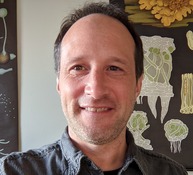 Abstract
Abstract
Here we inferred the underlying pathways by which symbiotic and phenotypic diversification occurred in one of the most iconic symbioses—lichens—while evaluating their ecological and macroevolutionary consequences. By inferring a time-scaled phylogeny of over 3300 species of lichen-forming fungi (LFF), we identified occasional instances of symbiotic instability that increased both the magnitude and diversity of lichen contributions to ecosystem processes from the Mesozoic through the Cenozoic. Symbiont switches broadly coincided with shifting environmental conditions, and the convergent evolution of phylogenetically or functionally similar associations in diverse lineages. We then inferred when LFF invaded arboreal habitats, and place them in a broader and more comparative framework by highlighting their paleoecological implications, and discussing them in the context of climate, vegetation, and the evolution of other epiphytic or arboreal lineages.
Dr. Matthew Nelsen research: https://www.fieldmuseum.org/about/staff/profile/2556
Host: Prof. Dr. Silke Werth
17.11.2021: Prof. Dr. Marc Gottschling. Systematics, Biodiversity and Evolution of Plants, Ludwig-Maximilians University of Munich, Germany. Presence/Stream.
Better the species you know: Exploring the diversity and distribution of unicellular dinophytes
 Abstract
Abstract
Type material of microorganisms, particularly of older taxa, consists of specimens mounted permanently on glass or mica slides or of illustrations only. In many cases, type material is ambiguous and makes reliable species determination problematic. For a correct application of such not only but also ambiguous scientific names in the microbial domain, the Shenzhen (‘botanical’) Code (ICN) provides a tool for designation of interpretative epitypes. The taxonomic identity of dinophytes is clarified by collecting samples at corresponding type localities. After establishing living strains, species are DNA-barcoded using rRNA sequences and investigated using contemporary light and scanning electron microscopy. Strains that are morphologically consistent with corresponding protologues are used for designation of interpretative epitypes. The significant difference from the historical types is that fully documented epitypes correspond to living material enabling DNA sequencing as well as experiments in ecology. Stable taxonomy and reliable species determination are particularly important to better understand occurrence and distribution of microorganisms in metabarcoding approaches. I will discuss promises and challenges of distribution studies in the microbial domain, where the development of reliable reference databases is crucial. The studies are necessary to better understand the organismic impacts of climate change or to improve applications such as the European Water Framework Directive.
Prof. Dr. Marc Gottschling research: https://scholar.google.com/citations?user=Cxn-Xv4AAAAJ&hl=en
24.11.2021: Dr. Christian Lampei. University of Marburg, Germany. Online Only.
Within-generation and transgenerational plasticity in the ecological context of annual plants
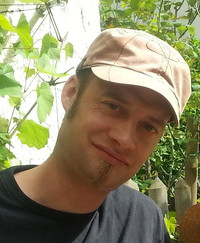 Abstract
Abstract
It may sound surprising, but plants can indeed, to some extend, learn to know their environment and pass this information on to the next generation. However, integrating this information into a plant's development is far from trivial and raises many questions. For example, under which environmental circumstances is the information from parents and grandparents important? And, does it matter if the environment keeps changing across generations, like during climate change? I will present a series of dedicated experiments that provide insights regarding the ecological context in which such learned knowledge is most advantageous for annual plants. The results should provide answers to some of these questions and optimally spawn a lively discussion.
Dr. Christian Lampei reserach: https://www.researchgate.net/profile/Christian-Lampei
Host: Prof. Dr. Dierk Wanke
01.12.2021: PD Dr. Simon Poppinga. Plant Biomechanics Group, Botanic Garden University of Freiburg, Germany. Online Only.
Plant movement physics and biomimetics
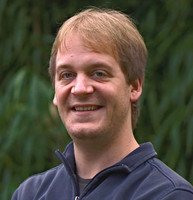 Abstract
Abstract
Although they do not have muscles, nerves and true hinges, plants can show spectacular movements. The motion principles are very diverse and have recently become a source of inspiration for the development of biomimetic compliant mechanisms, which are of great interest for various fields, e.g. soft robotics and architecture. In my talk, I will concisely summarize the physics of plant motion and procedures in biomimetic approaches. The work processes presented include basic biomechanical and functional-morphological investigations of fast and slow plant movements, the abstraction of functional principles, simulations and the transfer into novel materials systems and products. A focus is laid on systems, which are directly triggered and powered by changes of environmental conditions (i.e., humidity). With the help of such autonomous and self-sufficient actuators, reduced electrical consumption and maintenance are envisaged, which are important aspects for future technologies.
PD Dr. Simon Poppinga research: https://scholar.google.de/citations?user=GShKuywAAAAJ&hl=de
Host: PD Dr. Andreas Fleischmann
08.12.2021: Dr. Christoph Heibl. Naturschutz und Forschung Nationalparkverwaltung Bayerischer Wald, Grafenau, Germany. Online Only.
A species conservation program for the common adder (Vipera berus) in the Bohemian Forest – with comments on snake evolution and biogeography
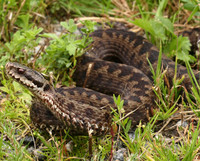 Abstract
Abstract
The low mountain range of the Bohemian Forest harbors one of the largest metapopulation of the Eurasian adder (Vipera berus) in central Europe and could be an important refuge for this “cold-loving” reptile under climate change. Nevertheless, little is known about the species’ population trends and genetic structure in the region. How does forest disturbance under a no-intervention policy in the national parks Bayerischer Wald and Šumava affect adder populations? How can we stop habitat loss in the surrounding cultural landscape and improve acceptance of the adder among locals and tourists? A new species conservation program will focus research and conservation measures on the conservation of this fascinating species.
Dr. Christoph Heibl research: https://www.researchgate.net/profile/Christoph-Heibl-2
Host: Dr. Simon Pfanzelt
Hybridization in Natural Populations
 Abstract
Abstract
Speciation can be conceptualized as a process during which reproductive barriers accumulate in the genomes of diverging populations. During the early stages of this process, reproductive barriers are generally incomplete allowing for gene flow that is mediated by first generation hybrids backcrossing into the parental populations. Hybridization thus is a natural component of species divergence with varied impact. It may slow down or reverse divergence, accelerate it via adaptive introgression, induce instantaneous isolation by allopolyploidization or open novel niche space to transgressive genotypic combinations. Whole genome sequencing data of natural populations allows insight into the evolutionary processes acting upon hybridization and may eventually help identify the reproductive barriers promoting species divergence. I will here present two examples of population divergence with gene flow from our own research. First, I will share some insights from a long-standing research program on the Eurasian crow superspecies complex forming two distinct hybrid zones in Europe and Russia. Second, I will describe the consequences of hybridization in natural populations of fission yeast. Though very different at first sight, these systems share a history of hybridization which they still carry in their genomes today.
Prof. Dr. Jochen Wolf research: https://scholar.google.com/citations?user=lsf37_QAAAAJ&hl=en
Host: Prof. Dr. Gudrun Kadereit
12.01.2022: Prof. Dr. Bettina Weber. University of Graz, Institute for Biology, Division of Plant Sciences, Austria. Online Only.
Cryptogamic communities – do they matter on a global scale?
 Abstract
Abstract
Cryptogamic communities (CC) are composed of lichens, bryophytes, cyanobacteria, algae, fungi and other bacteria in varying proportions. They occur on and in soil, rocks and epiphytically on the bark and even the leaves of shrubs and trees. It is well known that they are important primary colonizers, contribute to weathering and soil formation, and influence the local water balance, but also react quite sensitive upon air pollution.
In our research, we wanted to learn, if, besides these functional roles, they also influence global biogeochemical cycling processes. For this, we studied the role of CC in global carbon (C) and nitrogen (N) cycling. By means of modelling approaches, we analyzed their global C and N fixation and investigated the N cycling processes and the related emission of gaseous atmospherically relevant N compounds. Here, we observed that they are highly relevant in global N fixation and release both reactive and climate relevant compounds in the atmosphere.
In a recent study conducted in the Amazon rain forest, we analyzed if CC release also biogenic volatile organic compounds (BVOCs), a process up to now mainly ascribed to vascular plants. These BVOCs are highly reactive, influence the local ozone concentrations and the lifetime of greenhouse gases, and can form aerosol particles, which influence cloud formation and climate. Our measurements showed that bryophytes release major amounts of sesquiterpenoids, whereas lichens take up atmospheric oxidation products. A first calculation suggests that the amount of sesquiterpenes released by bryophytes is in a similar range as the quantities described for vascular vegetation.
Overall, our studies show that CC are relevant in various global processes, which up to now have not or only barely been considered. These mechanisms need to be included in global modeling approaches to obtain a more thorough understanding of the processes and drivers and to evaluate the role of CC in current and future environmental scenarios.
Prof. Dr. Bettina Weber research: https://biologie.uni-graz.at/de/ag-bettina-weber-funktionelle-diversitaet-oekologie/
Host: Prof. Dr. Silke Werth
19.01.2022. Dr. Barbara Ebert. German Federation for Biological Data e.V., Bremen, Germany. Online Only.
What happens to all the data? Insights into the new National Research Data Infrastructure in Germany
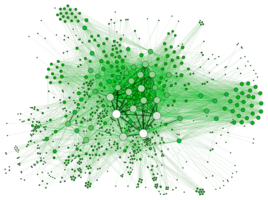 Abstract
Abstract
Research in all scientific domains produces an exponentially growing amount of data - however, much of it is not available in a form that makes it readily available for re-analysis or recombination. Even worse, a lot of data gets lost over time, hampering reproducibility of research as well as scientific progress.
In November 2018, the German Science Minister Conference GWK agreed on a 10-year initiative to structure research data services across different scientific domains in Germany. The talk will inform about the vision and the structure of the NFDI and NFDI4Biodiversity, and how we work with use cases from different areas of biodiversity research and nature conservation to understand their data needs. Existing support services for researchers will be briefly introduced, as well as the trusted data centers which provide them. The final part of the presentation will be a Q & A session with the audience, regarding their experiences with data management.
Dr. Barbara Ebert research: https://www.linkedin.com/in/barbaraebert/
Download PDF with the presentation
Host: Dr. Dagmar Triebel
26.01.2022. Dr. Jens Mutke. Nees Institute for Biodiversity of Plants, Rheinische Friedrich-Wilhelms- Universität Bonn, Germany. Online Only.
Biogeographic structure and diversity patterns of tropical montane forests in the South American Andes
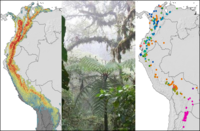
Abstract
The tropical Andes in western South America are a global center of biodiversity. Much of this diversity is associated with the tropical montane forests that span more than 3,500 km from north to south and across 3,000 meters of elevation. The large extent of these forests in a topographically complex and geologically active landscape results not only in a high overall species diversity. It stands to reason that this high heterogeneity of the landscape also results in a high species turnover, leading to a pronounced biogeographic regionalization in the tropical Andes. However, since the pioneering work of Alexander von Humboldt, little is still known about the factors controlling the species composition of these forests. In my talk, I explore what different datasets can tell us about plant diversity and the biogeography of the Andes, despite the still significant sampling biases. A large dataset of tree species inventories combined with multivariate statistics and bioclimatic modeling are used to identify gradients and clusters of floristic similarity.
Dr. Jens Mutke research: https://www.nees.uni-bonn.de/staff/pages/jens-mutke
Host: Dr. Andreas Gröger
02.02.2022. Prof. Dr. Micah Dunthorn. Natural History Museum, University of Oslo, Norway. (Postponed for 27.04.2022)
Equating OTUs with Species Diversity
 Abstract
Abstract
Species are fundamental biological units used in ecological and evolutionary analyses. Because protistan diversity is so large and their morphological characters are so small, molecular methodologies are the only way that we can attempt to uncover most protistan species in complex environmental samples. One step in the sequencing-bioinformatics pipeline of molecular methodologies is clustering sequencing reads into operational taxonomic units (OTUs). These OTUs are used in the place of species in downstream analyses. Here I will discuss the underlying assumptions that different clustering methods make in how they handle metabarcoding data. I will then discuss how these differently constructed OTUs may or may not equate with our concepts of species and with the operational criteria that we use to delimitate species in nature.
Prof. Dr. Micah Dunthorn research: https://www.nhm.uio.no/english/about/organization/research-collections/people/michad/
Host: Prof. Dr. Marc Gottschling
09.02.2022. Thibaud Messerschmid. Systematics, Biodiversity and Evolution of Plants, Ludwig-Maximilians University of Munich, Germany. Online Only.
Processes of evolutionary diversification in Aeonium (Crassulaceae), the most species-rich plant genus of Macaronesian endemics
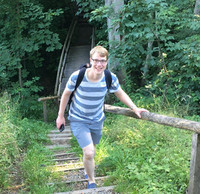 Abstract
Abstract
Oceanic archipelagos are regarded as natural laboratories for the study of evolution and hold a wealth of examples of endemic plant radiations. The Canary Islands form an archipelago in the Macaronesian floristic region and have a rich history of botanical research. The most species-rich and ecologically diverse plant radiation (largely) endemic to the Canary Islands is the Aeonium alliance (Crassulaceae). We studied the biogeographic and ecological setting of diversification processes in Aeonium on the basis of a well-sampled and supported phylogeny inferred using a modified ddRADseq approach. Our results show that Aeonium is one of few examples of island radiations that successfully re-colonized the continental mainland twice, probably owing to its preference for competition-poor habitats. Founder-event speciation by migration from one island to another and sympatric speciation within single islands were inferred to have taken place in equal parts, underpinning the importance of geographic isolation as well as ecological speciation in island radiations. Furthermore, in lineages that diversified within single islands, morphological and ecological disparity was more pronounced than in lineages with frequent allopatric speciation. These findings imply that diversification of Aeonium resulted both from adaptive and geographic processes and meets the requirements to be regarded as a case of adaptive radiation.
Thibaud Messerschmid's research: https://scholar.google.com/citations?hl=de&user=hsMapJEAAAAJ
Host: Prof. Dr. Dierk Wanke
16.02.2022. Prof. Dr. Pablo Vargas Gómez. Real Jardín Botánico de Madrid, CSIC, Spain. Online Only.
A paradigm shift in the study of plant colonization
 Abstract
Abstract
For most of the 19th and 20th centuries, scholars assumed that dispersal was closely linked to specific sets of diaspore traits (syndromes). In particular, four long-distance dispersal (LDD) modes have generally been considered to play central roles in the colonization of islands by plants: anemochory (dispersal by wind), thalassochory (dispersal by oceanic currents), endozoochory (internal dispersal by animals) and epizoochory (external dispersal by animals). However, since nobody has witnessed the arrival of early plant colonists on isolated territories (islands), the actual LDD has historically been a matter of speculation. Indeed, new evidence reveal that seeds can also be transported by vectors different from those to which they are best suited (non-standard dispersal), meaning that the actual vector of colonization cannot be inferred simply based on diaspore traits. Speculations about plant colonization should be therefore avoided, albeit perform a more evolutionary approach by testing whether plants displaying diaspore specializations have been favored in LDD. We propose an alternative approach to explore the relative contribution of LDD syndromes to island colonization (Galápagos, Canary Islands, Azores). Indeed, a growing field of research combining classical (syndrome categorization, floristics, paleobotany) and new (phylogenetics, phylogeography) data help analyse whether LDD syndromes have been favoured in the colonization of oceanic islands.
Prof. Dr. Pablo Vargas Gómez research: http://www.rjb.csic.es/jardinbotanico/jardin/contenido.php?Pag=386&tipo=cientifico&cod=96&len=es
Host: Prof. Dr. Gudrun Kadereit
23.02.2022: Dr. Linnea Hesse. Plant Biomechanics Group Freiburg, Albert-Ludwigs-Universität Freiburg, Germany.
Plants can inspire technology: Modern methods in plant biomimetics
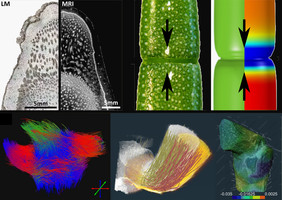 Abstract
Abstract
Plants have undergone rigorous quality control throughout evolution. The results are organisms with unique form-structure-function principles that reveal intelligent solutions to various challenges that we humans can learn from and transfer to technical systems. In the field of plant biomimetics, novel technical material systems have been developed which mimic the function of biological material systems or processes. However, it is not always easy to assign a specific function to a biological design which is further complicated by their multifunctionality. For this reason, the further development of methods for the functional analysis of model organisms is a central task of bionic research. Some modern methods in plant biomimetics are finite element modelling as well as static and dynamic 3D to 4D imaging methods (µCT and MRI) which give novel insight into self-sealing mechanisms in leaves of Delosperma and a load adapted fiber-reinforced design and development of monocot stems.
Dr. Linnea Hesse research: https://scholar.google.de/citations?user=HvelwUAAAAAJ&hl=de
Host: Prof. Dr. Gudrun Kadereit

